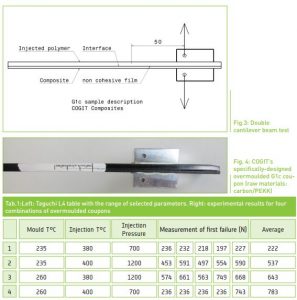JEC article about COGIT expertise in overmolding process to aeronautic application
A JEC article (JCM 135) displays one of COGIT’s original approach to characterize the interface quality of overmolded interface between thermoplastic composite and PEKK over injected.
Extract of the article :
Using the overmolding process to manufacture aeronautic carbon/PAEK parts requires a better understanding of cohesion between thermoplastic materials. To determine the influence of process parameters on parts, a method of characterization was established and simulation was performed.
Thermo-stamping process enables to manufacture carbon PAEK composite parts in a short cycle and the overmolding one brings new opportunities of integrated functions onto aeronautic parts. Demonstrators opened the innovation window but the readiness level stays rather low. One reason is the lack of knowledge about cohesion between the thermoplastic composite (Carbon/PEAK) and the over injected re-inforced polymers (Carbon/PEAK). The goal is to guarantee a good strength transfer between these two materials all along the aircraft life.
…
Overmolding challenge in aeronautic industry
Whereas composite structural analysis is well-managed by aeronautic design unit, the injected part analysis is less common, especially for structural application. Beyond the technological demonstrators, the remaining fear concerns the cohesion between composite and injected items. The means to characterize and justify the interface aren’t described into mechanical standards. The full certification process has to be built.
Experimentation
This study focused on interface cohesion vs process parameters thanks to specific coupons since no normalized test exits. A design of experiments investigates the most interesting process window. Then, the G1c, G2c parameters are determined so as to feed values into stress analysis.
Characterization test for overmolded interface
As no specific test exists about overmolded interface, the choice must be oriented by standards dealing with bonding joint, inter-laminar toughness. Classical mechanical test enables to characterize cohesive interface (see Figure 3). End Notched Flexural Test (ENF) brings shear values whereas Double Cantilever Beam Test and T Peel Test bring normal values.
…
COGIT Composites Choice
Following the principle of the ASTM D5528 and ASTM D6671 standards, concerning Mode I and Mode II inter-laminar fracture toughness, the coupon (see figure) is adjusted to balance the behaviour of two different raw materials on each sides of the interface. As strength limits and moduli are different, the thickness becomes the parameter to customize. For this topic, a mould is designed so as to produce it.
Specific coupon
So as to manufacture this coupon, a stamping press coupled with injection unit welcomes the dedicated mould. The main press features are 65 tons and up to 450°C table. For injection, a 45cc injection screw that can be heated up to 420°C and the pressure can reach 2200 bars has been used.

Figure 4: COGIT specific design overmolded G1c coupon
(raw materials : Carbon/PEKK)
The capabilities of this tools enable to investigate any kind of composites and polymers, like PA, PPS, PEI, PEEK and PEKK with or without fibre. For this study, Carbon/PEKK composite is overmolded by PEKK reinforced by carbon fibre (ARKEMA 8010C30).
…
Conclusions
Overmolding in aeronautic applications can be investigated by the proposed specific coupon which contributes to measure Mode I and also Mode II toughness. A design of experiments helps to tune process parameters so as to reach better allowable values for design team. The flow simulation brings a physical understanding of relationship between failure strength and process parameters. Indeed, the time spent beyond melting point and energy flux received by composite surface drive the interface quality. This measurements and simulations enlighten the field of design opportunities and consequently cost reduction by this fast and automated process. The illustrated expertise invite to find out more about abilities of overmolded advanced composite parts.
Auteurs :
Christophe Roua, CEO COGIT Composites
Gilles Angin, Project Manager COGIT Composites
Arnaud Clou, R&D Engineer COGIT Composites
